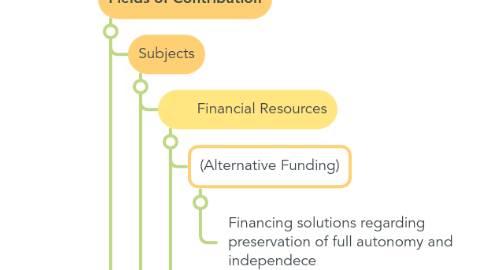
1. How to use this template
2. My Personality
2.1. Expertise
2.1.1. Professional Ethics
2.1.2. Emotional Intelligence
2.1.3. Sustainable Systemization
2.1.4. Planning
2.1.5. Environmental Awareness
2.1.6. Conscious Behavior
2.1.7. Harmonization
2.1.8. Growth & Naturalism & Expansion
2.2. Skills
2.2.1. Ecological Transition and Climate Change Adaptation
2.2.2. Financial Analysis and Strategic Planning
2.2.3. Research and Data Analysis
2.2.4. Writing and Communication
2.2.5. Adaptability, Autonomy, and Initiative
2.2.6. Team Leadership and Collaboration
2.2.7. Extreme Learning & Flexibility
3. Projects
3.1. Energies2050
3.1.1. Complete Abillity & Competence to Accomodate everything at hand
3.2. FEDECOM (Horizon Europe)
3.2.1. Spanish Virtual Green Hydrogen Federation
3.2.1.1. Implement advanced control strategies and feasibility studies to optimize operations. Foster community engagement through educational workshops and participatory planning sessions
3.2.2. Swiss Residential Hydropower Federation
3.2.2.1. Use data analytics to drive efficiency improvements. Promote local energy trading platforms and incentivize user participation through gamification and rewards
3.2.3. Benelux Cross-country E-Mobility Federation
3.2.3.1. Develop interoperable systems for seamless energy exchange and EV integration. Facilitate cross-border collaboration to share best practices and technologies
3.3. HESTIA (Horizon Europe)
3.3.1. User-Centric Energy Services
3.3.1.1. Utilize data analytics and machine learning to create tailored energy services. Engage users through interactive platforms and feedback mechanisms to ensure their needs are met
3.3.2. Community Engagement
3.3.2.1. Organize workshops, seminars, and community meetings to educate and involve local residents. Create incentives for participation, such as rewards for energy-saving behaviors
3.3.3. Resilience of Local Energy Systems
3.3.3.1. Implement advanced control systems and predictive maintenance strategies to enhance system resilience. Foster collaborations with local grid operators and stakeholders to address potential challenges proactively
3.4. LEAF (ERASMUS+)
3.4.1. Community Engagement
3.4.1.1. Organize community events, such as biodiversity fairs, planting days, and conservation workshops. Provide incentives for participation, such as certificates, recognition, or small rewards
3.4.2. Educational Initiatives
3.4.2.1. Develop interactive and experiential learning modules, workshops, and field trips. Collaborate with educators to create engaging and relevant content that can be easily incorporated into their teaching plans
3.4.3. Sustainable Practices
3.4.3.1. Promote best practices through educational materials, demonstrations, and pilot projects. Collaborate with local businesses and organizations to showcase sustainable practices and their benefits
4. Analysis
4.1. Objectives
4.1.1. Goals
4.1.2. Scope
4.1.3. Requirements
4.2. Actions
4.2.1. Immediate
4.2.1.1. Review
4.2.1.1.1. Documentation
4.2.1.2. Interviews
4.2.1.2.1. Stakeholders
4.2.1.3. Performance
4.2.1.3.1. Past
5. Fields of Contribution
5.1. Subjects
5.1.1. Financial Resources
5.1.1.1. (Alternative Funding)
5.1.1.1.1. Financing solutions regarding preservation of full autonomy and independece
5.1.1.2. (Cost Allocation/Optimization)
5.1.1.2.1. Flow of resources to ensure the continuity of the project
5.1.1.3. (Budgeting)
5.1.1.3.1. Suitably for expansion purposes
5.1.1.4. (Forecasting)
5.1.1.4.1. Innactivity risk limitation
5.1.2. Internal Communication
5.1.2.1. (Reporting Mechanisms)
5.1.2.2. (Collaborating Mechanisms)
5.1.2.3. (Information Comprehension Frameworks)
5.1.3. Public Image Expansion
5.1.3.1. (Social Media)
5.1.3.1.1. Video Blogs
5.1.3.1.2. Success Stories
5.1.3.1.3. Economic & Social Impact highlights
5.1.3.1.4. Gamification
5.1.3.2. (Campaigns)
5.1.3.2.1. Media Outlest
5.1.3.2.2. Public Events
5.2. Organization
5.2.1. Research Teams
5.2.1.1. Provision/Facilitation
5.2.1.1.1. Resources
5.2.1.1.2. Collaborative Connections/Partnerships
5.2.1.1.3. Methodological frameworks
5.2.2. Workshops
5.2.2.1. Brainstorm
6. Problems
6.1. Prioritization
6.1.1. Impact
6.1.2. Feasibility
6.2. Type of Contribution
6.2.1. Focus
6.2.1.1. Enhance
6.2.1.2. Optimize
6.2.1.3. Develop
6.2.1.4. Organization's Risk & Strategy Framework (Optional) (Possibility to provide this framework in detail to the research teams).
6.2.1.4.1. Analysis
